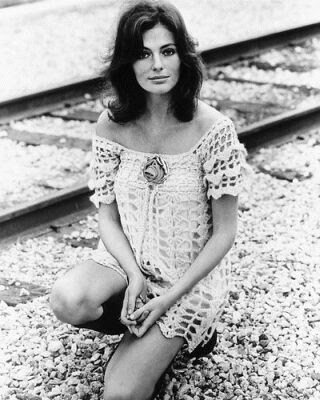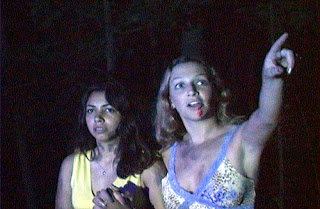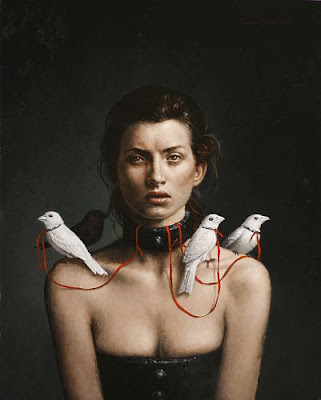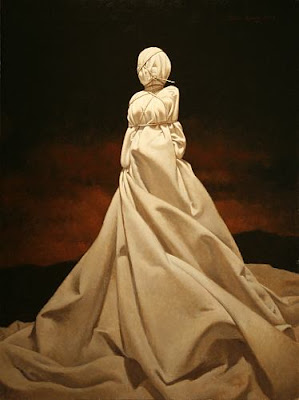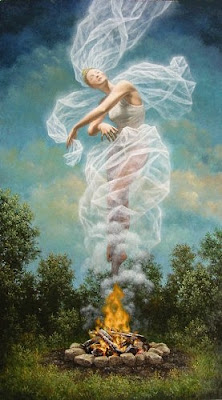The Craving (2008) Starring: Lesley Paterson, Grayson Berry, Wallis Herst, Jesse Boyd, Anselm Clinard, Curtis Krick, and Jason Kehler
Director: Sean Dillon
Rating: Eight of Ten Stars
Five friends on their way to the Burning Man festival (Berry, Boyd, Clinard, Grayson, and Herst) take a shortcut across the desert, only to get lost. When the drive up to a ramshackle cabin, its crazed resident (Krick) opens fire on them with a shotgun, disabling their van and causing them to be trapped with him in the desert. The murderous hermit is the least of their worries, however, because when night falls, a creature emerges from its den... and it is very, very hungry.

"The Craving" is an old-fashioned monster movie with a very modern sensibility. The set-up is like any number of "beautiful young people on a road trip Meet a Bad End" movie that you've seen in recent years, but it quickly veers into a territory that's as stylish and well-photographed as anything Terence Fisher or Mario Bava ever offered up, and as gritty and intense as early Tobe Hooper and Wes Craven films with each other.
What seperates this film from the pack it shares some similarities with is its well-crafted script and the performances given by its actors. It may be a fairly traditional tale of a group of dimwitted people stranded in the wilderness with a monster that's messily picking them off one by one, but it's told with a style that's all-too-rarely seen in movies of this sort.
First of all, it delivers a number of unexpected twists as the story unfolds, but they're not the out-of-left field sort of twists that are increasingly the norm in horror films. The twists here are either well-founded in the plot (our crazed hermit has a very good reason for hanging out in the desert... and it's a reason that's both obvious and shocking and one that is in complete keeping with the theme and nature of the story) or ones that play with our expectations for how this sort of movie unfolds and concludes (it may be a small thing, but I really appreciated the third-act violations of conventions as far as the deaths of main characters and the order they get dispatched in--and no, that's not a spoiler... I mean, we don't expect ANYONE to survive in movies these days, do we?).
Second, the script presents dialogue that is far better crafted than what we've come to expect as standard these days. Not only do we have dialogue here that sounds the way real people might talk but screenwriter Curtis Krick has given each character a unique speech patterns and sound. It's dialogue that lets the actors bring their characters fully to live and make them believable even when they are doing things that I found unbelievable. (The only complaint I have in the "there went my suspension of disbelief" category is when two characters have sex after one has suffered a severely broken leg. Yes, he's on pain-killers, but, having been where he's at as far as broken bones go, I don't think they'd have been enough to dull the pain to the point where I'd be interested in a romp. Wallis Herst's character, Diane, is definatelly the sort of girl that every guy in the 20s dreams of having and every man in his 50s is a little fearful of... but I don't think Scotty would have been able to accomodate her with her broken leg, no matter how funny I found the scene.)
Another thing I found laudible in the film is the amazing use of sound in it. Too many indie films (and even a few studio efforts with huge budgets) suffer because not enough attention is paid to sound-mixing or the proper use of music.
"Curtis and I created a version of the film with sound effects added, but we soon realized that the film would only reach its potential if we engaged a really talented person to complete the movie's sound," director/producer Sean Dillon commented to me when I mentioned how spectacular the use of sound is in the film. "Then we found Josh Eckberg, a wonderfully talented sound designer and editor who shared our vision for the film. He found the time to do the sound right. For 'The Craving,' we understood how much of the tension came from the sound of the creature. If we hear it, we know it's near, but we still don't know exactly where. That can be much scarier than actually seeing the creature onscreen. Josh had the skills and the resources to actually execute an ambitious sound design."
The soundtrack music used in the film is also great. Composed by Krick, it's not the sort of music that calls attention to itself and instead builds tension and horror where it is deployed on an almost subliminal level. It's not only an example of great score music, but it's an example that other filmmakers should follow when placing soundtrack music in their films. For a first feature-length effort, it's exceptionally well done.
I just realized that I've gotten almost to the end of this review without discussing the film's monster. That oversight is a symptom of my desire to keep my posts here short and because Dillon and his crew handled the monster exactly as they should have.
The creature is "The Craving" is a bizarre one, with a number of surprising traits and behaviors, yet ones we can buy into as the film unfolds. I had a small WFT moment during the first monster attack, a moment where I couldn't quite get a read on what was going with the characters and their conflicting reactions to the creature's strong body odor and Diane's really bizarre behavior. However, as the film continued, it started to make sense and it made the creature even scarier.
Although the film takes place in the middle of the desert and the creature here isn't hairy--it looks like it's completely smooth-skinned it the quick glimpses we get of it--there are a number of things about it that reminded me of Bigfoot legends. Heck, the monster here explained some of the Bigfoot stories better than the Bigfoot stories do, such as why some people describe a strong stench around the creature while others don't, and why some say Bigfoot is frightening and others claim it to be a kind and benevolent creature. The strange creature is better thought out and more logical than something that many people believe is real.
In addition to being cleverly conceived from a story point of view, the monster in "The Craving" is also expertly handled from the technical aspects of horror filmmaking. Dillon and his crew wisely chose to have the monster remain mostly hidden from the viewer, showing only glimpses of it. This keeps the creature as frightening as possible as it then ends up residing mostly in the audiences imagination, causing us to picture something far more terrible than anything that could probably have been put screen--and given the highly effective and convincing gore we do see,
I think most of will imagine the creature as pretty damn horrible.
By keeping the creature's screen appearances limited to silhouettes and quick glimpses, Dillon not only shows that less really is more when it comes to this sort of thing, but any possible weaknesses in their monster design and make-up are also kept from view. This is not one of those independent horror films where the creators screw up their movie by giving the audience extended shots of a badly done monster. The opposite is the case here--we've got a good-looking moster that is still shown sparsely and thus becomes even scarier. (Dillon told me that the monster make-up and look improved as filming progressed, so it could be those few excellent glimpses we get were late in filmed late in the shoot. Whatever the case, the creature looks great, better than those featured even in films you may come across during "the most dangerous night of television" on your favorite cable channel. If the look of the creature improved as the film unfolded, then it ended up in such an excellent place and was otherwise so artfully filmed that the we'd never have known it wasn't perfected before filming began.)
In fact, everything in this film is so well done that you'd never know the film was shot in over a mere two weeks, with some of the cast being available only part of the time because of other commitments, severe weather impacting the shoot, and many of the people involved in the production wearing many different hats both in front and behind the camera. It's a film that has the look and feel of a movie shot over a much longer period, and for a whole lot more money than the good people from Biscuits and Gravy Productions had access to. It's a film that shows what a talented group of dedicated creators who know their craft can come up with.





